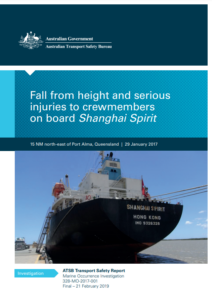The Australian Transportation Safety Bureau (ATSB) issued an investigation report on a serious injury of two crew members onboard the Hong Kong-flagged bulk carrier ‘Shanghai Spirit’, northeast of Port Alma, Queensland. The ATSB found that, contrary to established procedures, the two crew remained on the unsecured scaffold tower in preparation for repositioning, rendering it top-heavy and unstable.
The incident
During the afternoon of 29 January 2017, the deck crewmembers of ‘Shanghai Spirit’ were conducting painting and routine touch-up work in the cargo holds. They used a mobile scaffold tower to access areas of bulkhead about 6 to 9 m above the hold bottom. Two crewmembers conducted the work from the upper tiers of the scaffold tower and remained unsecured on it when it was moved.
To access the full length of the hold bulkhead, the work required repositioning the scaffold tower on multiple occasions. After the work on the aft bulkhead was completed, it was decided to paint the hopper tank edge. As the scaffold tower was moved with the unsecured crewmembers, it became unbalanced and toppled forward onto the deck.
The two crewmembers on the scaffold tower were seriously injured in the fall and were evacuated to a hospital ashore for treatment.
Findings
The ATSB found that, contrary to established procedures, two crewmembers remained on the unsecured scaffold tower in preparation for repositioning, rendering it top-heavy and unstable. Consequently, when moved it toppled and fell. Additionally, neither crewmember on the scaffold tower utilised the required safety harness and associated safety lines which would have prevented them falling when climbing or working on the tower.
Finally, the afternoon work in hold number four was not supervised by an officer as required by company procedure and in contrast to the morning activity. The absence of formal supervision, in combination with a desire to expedite the task in difficult working conditions, probably led to the crewmembers remaining unsecured on the scaffolding as it was repositioned.
Other contributing factors identified:
- The assembly and condition of the scaffold tower had several defects, which exacerbated the unstable state of the structure.
- Guidelines for the provision, care and use of the scaffold tower, was not supported by suitable on-board documentation. The only documentation was for mobile scaffolding equipment of a different design, and not for that in use on the ship. [Safety issue]
- Neither crewmember on the scaffold tower utilised the required safety harness and associated safety lines which would have prevented them falling when climbing or working on the tower.
Actions taken
- The scaffolding equipment operating instructions and maintenance manuals/guidelines have been included in the company’s safety management system. Further, there is now a requirement for monthly and quarterly inspection of the equipment.
- The use of scaffolding is now specifically classed as ‘working at heights’ and is therefore subject to all planning and precautionary measures such as risk assessment, working aloft permits and precautions.
- Personnel Protective Equipment training and awareness has been reviewed and enhanced. Additionally, new crewmembers will be subject to pre-joining training that now includes the use of scaffolding.
Lessons learned
This accident highlights the importance of adhering to procedures that assure safety as well as the value of effective supervision. Owners, operators and crewmembers are reminded to plan and undertake risk assessments for assigned tasks in order to identify any shortcomings in procedures and required risk-mitigation measures.
Explore more herebelow:





























































